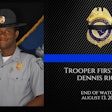Back in 1988, Calibre Press released a stunning law enforcement training tape titled "Surviving Edged Weapons." It included a sequence that showed how long it takes the average officer to draw and fire his or her sidearm when reacting to a charging, knife-wielding suspect.
In repeated scenarios of similar attacks with different officers, the video reveals that it takes about one-and-a-half seconds for the officer to draw and fire two shots. From that time reading, the narrator determines that the attacker could be as far away as 21 feet and still stab the officer before he could effectively fire his handgun. The tape then goes on to discuss tactical alternatives such as side stepping the opponent or using intervening objects to disrupt the line of attack.
The tape is great, but it has led to a dangerous myth. Over the years, this simple demonstration of draw speed has morphed into an astounding misconception that now permeates law enforcement and security training, "The 21-Foot Rule."
Let's take a close look at why this almost universal law enforcement myth is dead wrong.
Expanding the Circle
Research by Dr. Bill Lewinski of The Force Science Research Center and Dr. Marvin Fackler has repeatedly shown that officer reaction times are significantly longer than commonly believed.
Now consider that the officers on the Calibre tape knew where the suspect was, what he was armed with, and that he was about to charge. On the tape, the suspect begins to move and the officer begins to draw. That eliminates the real-world delays of perceiving the threat and then making the decision to defend with gunfire.
The Force Science Research Center has shown that it takes the average officer about half a second to perceive a threat and approximately another half second to decide what to do about it. All of this has to happen before the officer begins his or her draw stroke. What this means is that with the threat closing at seven feet per half second, we are closer to a 35-foot rule.
And it is extremely difficult to smoothly draw and accurately fire when under a life-threatening attack. So that means that we had better add another 10 feet to allow for the attacker to keep coming if we miss center mass or even if we hit him, even mortally wound him, and he doesn't go down.
It's now the 45-foot rule.
Behind the Reaction Curve
A few years ago, a scenario was set up to surprise the cadets at a police academy. A single target was placed to one side of the range. During a break in the training two days later, an instructor walked up behind an armed cadet and calmly said, "The blue target to your left is a threat. Shoot it twice. Now!"
The average time for each student to accomplish this test was 2.6 seconds. A 2.6-second draw and fire time translates to about 37 feet of suspect motion.
And realize that the students were told there was a threat and what force to apply. Only the element of surprise was added to the encounter. Without the instructor's command, we must add seven feet for discovery of the threat and another seven feet for the decision to shoot. That's a grand total of 51 feet.
Closing the Reaction Gap
The first thing we have to discuss is what we would do in an actual attack. If you really know the suspect is about to charge, wouldn't you prudently draw your firearm to at least a low ready position before the suspect charged?
Also, once the suspect attacked, wouldn't you give ground to increase the distance between you and his knife? Wouldn't you also seek the cover of some intervening object to slow your opponent's charge?
Finally, as the ultimate delaying tactic, wouldn't you also place some shots across the attacker's pelvic girdle rather than center mass to break a hip or leg bone and perhaps cause the suspect to fall?
There are a number of ways to reduce our newly established 45- to 51-foot danger zone.
You should remain alert to the suspect's hands and motion, keep as much distance as practical from the suspect, and have a preplanned direction of escape. Be aware of intervening objects that could reduce the speed of an attacker or force a change in his direction.
No Line in the Sand
Despite what some would have you believe, there is no 21-foot kill zone. Deciding when to shoot a suspect who is holding a knife is one of the toughest judgment calls you will ever make.
Some years ago while on patrol, my partner and I observed a young fellow chasing another down the Las Vegas Strip at 2 A.M. while swinging a machete in the air. We pulled over to intervene and, as I exited the car, I commanded him to drop his weapon.
He pointed his finger at his chest and looked around in an apparent effort to see if I was shouting at him or someone else. As I assured him I meant him, he began meandering toward me as if he could not hear.
The distance quickly closed to 15 feet. I gave a few feet of ground and leveled my SIG on his chest; he suddenly placed the machete down on the sidewalk and followed my directions to place his hands on our patrol vehicle fender.
I soon learned that his beef with the intended victim was caused by a shouted obscenity. A bit more investigation revealed that this subject was severely mentally retarded.
Should I have shot him under "The 21-foot rule?" Maybe, but he appeared to be confused and, at least when I confronted him, non-threatening.
Could I have shot him legally? I presume I could have. And don't get me wrong, I would never second guess any officer firing under similar circumstances. These are judgment calls based on your experience and the totality of known circumstances.
And not everyone closer than 21 feet with an edged weapon is a real threat. It's the totality of the circumstances and not the 21-foot rule that determines whether you should fire.
A determined attacker can easily close a 21-foot distance much faster than a surprised officer can perceive the threat and neutralize it by shooting. Sometimes, however, even inside of 21 feet, the attacker is not a true danger. Never assume that any specific distance provides a safe zone (or a free fire zone) on the street.
Training Solutions
A "charging attacker" drill can be set up quickly and inexpensively.
On your training range, install a wire seven or eight feet off the ground on one lane from your backstop to the area behind the firing line. Parallel to this wire, attach a foot-long piece of two-by-two wood using cup hooks so the wood can slide back and forth along the wire. From the center of the two-by-two, run a one-by-two board down toward the ground and staple onto it a cardboard IPSC-type target at human height. As an alternative you can mount a cardboard target backer and staple on your qualification silhouette. A string attached to the end of the two-by-two can then be used to pull the target toward the shooter.
Now place the shooter at seven yards with his firearm at low ready and have him engage the target when it moves toward him. The instructor pulling the string controls the speed from meandering suspect to a full-out charging opponent. Next try the same drill starting with a holstered handgun.
During these drills, it is important to keep another instructor right behind the shooter to prevent him or her from turning and firing sideways as the target passes.
For a real eye opener, try this from a normal "hostile interview" distance of 6 to 8 feet. You will quickly learn that you have no chance to draw and fire fast enough to stop this type of threat. You must give ground, side step, or use objects to disrupt the subject's line of charge. After running this training drill a few times, you will rethink the 21-foot rule.
Bob Irwin is a lieutenant with the Boulder Constable's Office and operates The Gun Store in Las Vegas, Nev. He has taught firearms and use of force in 28 police academies over his 35-year career and teaches Law Enforcement Instructors for Nevada POST as well as civilian instructors for the NRA.












